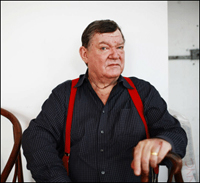 The Mona Lisa Curse l
The Mona Lisa Curse lLast Updated: 12:01am BST 18/09/2008
This week’s Hirst auction summed up what’s wrong with art, Robert Hughes tells Andrew Pettie
At Sotheby’s on Tuesday an anonymous bidder bought a bull in a tank of formaldehyde for £10.3million. The world’s most expensive cut of beef was cooked up, inevitably, by the artist Damien Hirst, whose “Beautiful Inside My Head Forever” sale of 223 new works fetched £111.5million, a record for an auction dedicated to one artist. The illustrious Australian art critic Robert Hughes, however, isn’t buying the hype.
Picture of discontent: critic Robert Hughes says big money is distorting art
This is partly because Hughes – who presents The Mona Lisa Curse, a one-off polemic broadcast on Channel 4 this Sunday – considers Hirst’s work flashy and fatuous. Indeed he has described one of the British artist’s sharks in formaldehyde as “the world’s most overrated marine organism”.
But Hughes’s central beef with Hirst’s headline-grabbing success is that it illustrates how today’s mercenary art market has made the price of a work of art more significant than its meaning.
“The idea that there is some special magic attached to Hirst’s work that shoves it into the multimillion pound realm is ludicrous,” Hughes says. “[The price] has to do with promotion and publicity and not with the quality of the works themselves.”
In The Mona Lisa Curse, Hughes traces the pernicious rise of the commercial art market back to 1963, when Leonardo da Vinci’s most famous portrait was exhibited in New York. The Mona Lisa, says Hughes, was treated “as thought it were a film star. People came not to look at it, but to say that they’d seen it.”
This “feeding frenzy” over a single painting marked the start of a process by which works of art became celebrities in their own right. And from the 1960s onwards, as Hughes recounts, acquisitive collectors started buying works of art not because they liked them, but because they expected a financial return.
Hughes’s film argues that art is the biggest unregulated market in the world apart from drugs. Contemporary art sales, such as Hirst’s, rake in £10billion a year. Modern art is dottily expensive to buy not, says Hughes, because it’s so good, but because investors believe it will yield quick profits.
“The commercial art market places too much emphasis upon novelty and trendiness,” he says, “because buyers expect that new work will get more valuable in the short-term.”
Of course, a work of art’s net worth – unlike a company’s – can’t be subjected to objective scrutiny. So those artists, such as Hirst, who attract controversy or have a flair for self-promotion are able to inflate the price of their work with some cleverly orchestrated PR. Moreover, collectors who have already invested in these artists would be fools not to play along, as Hughes explains.
“The market is manipulated by collectors who decide to bid up the work of an artist [they’ve already invested in],” he says. “So when artist X comes up on the auction block, the collectors all bid it up, so that they can then multiply the value of their existing holdings in artist X by the value of the inflated sale.”
The relentless upward surge in prices has two regrettable consequences. First, art becomes seen as a commodity, something to be owned as much as appreciated. Second, the only places ordinary people can experience celebrated works of art at first-hand – museums and public galleries ¬– are now priced out of the auction room.
“Instead of being the common property of humankind the way a book is, art becomes the particular property of somebody who can afford it,” Hughes says. “And when you have some Russian squillionaire who started buying art three minutes ago but has the GNP of Georgia in his pocket, how can museums compete? They can’t – which causes great social harm. Suppose that every worthwhile book in the world cost $1million ¬– imagine what a catastrophic effect on culture that would have.”
All this makes depressing reading for art lovers. But if on the same day that the world’s financial markets plummeted in panic, Damien Hirst’s art was selling for record sums, shouldn’t everyone be ploughing their savings into artificially preserved farm animals?
“One of the things that sustains the art market is an irrational faith in a continuous rise in prices,” says Hughes. “There was a 17th-century Italian painter called Guido Reni. Not a lot of people have heard of him but in the late 18th century many connoisseurs thought that Italy’s two supreme artists were Michelangelo and Reni. But by 1950 you could buy a 10ft painting by Reni for £300. People fall out of fashion quite rapidly. So this idea of the inviolability of the modern art market is a fantasy.”
 The Mona Lisa Curse l
The Mona Lisa Curse l